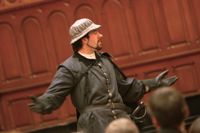- Edition: King Leir
King Leir
- Introduction
- Texts of this edition
- Contextual materials
- Facsimiles
65King Leir, Scene 9
Cast
Gonorill: Matthew Krist
Skalliger: David Kynaston
The Queen's Men Dramaturgy: Moral Dichotomy (Sc. 9)
66Read about Queen's Men moral dichotomy in Scene 3.
The events of Leir 8 and 9 are captured in Shakespeare's Scene 3; by comparing how these plays treat the material, we can recognize the differences in dramaturgy. Lear 1.3 begins with Goneril asking for confirmation from her steward that Lear has struck one of her "Gentlemen" ( ![]() F: 507) . Her complaint is short and to the point and situated within the business of running a household. She leaves having given her steward instructions to slight the king, an instruction that motivates the action of the next scene. In the Queen's Men scene Gonorill asks for advice from Skalliger. Skalliger tells her to "abridge" (TLN 801) the king's "allowance" (TLN 799) in "half" (TLN 801) at which she promptly informs him she has done so already but will half her father's allowance again on Skalliger's advice. Delighted to find Skalliger conformable to her own inclination, she exits. Skalliger, left on stage, calls her a "viperous woman" ( TLN 811) and anticipates heaven's revenge on her and on himself before exiting, never to be seen again.
F: 507) . Her complaint is short and to the point and situated within the business of running a household. She leaves having given her steward instructions to slight the king, an instruction that motivates the action of the next scene. In the Queen's Men scene Gonorill asks for advice from Skalliger. Skalliger tells her to "abridge" (TLN 801) the king's "allowance" (TLN 799) in "half" (TLN 801) at which she promptly informs him she has done so already but will half her father's allowance again on Skalliger's advice. Delighted to find Skalliger conformable to her own inclination, she exits. Skalliger, left on stage, calls her a "viperous woman" ( TLN 811) and anticipates heaven's revenge on her and on himself before exiting, never to be seen again.
67 Shakespeare's scene is a tightly wound 23 lines compared to 43 in Leir. If we were to judge the scenes in terms of dramaturgical efficiency and unity of action then Shakespeare would win hands down, but what does the Queen's Men play do that Shakespeare does not? In performance, Matthew Krist played Gonorill's initial speech with a brazen outrage, unleashing a vicious attack on her father and then seductively inviting Skalliger to find a solution. She then turned the tables at the end to reveal she has already taken action independent of his advice. The turn surprised Skalliger as much as the audience and prompted his commentary on her wickedness and his regret that he has to live by flattery (TLN 816). Conceived in this way, the scene becomes an opportunity for the actor playing Gonorill to demonstrate the vicious nature of the character and for the company to pass moral commentary on the corrupt world through the mouth of Skalliger. The key difference between the Queen's Men play and Shakespeare's is the lack of evidence to support Gonorill's opinion of her father's behavior. In Lear Kent does trip Goneril's servant giving a degree of justification to her actions. Leir has done nothing to provoke his daughters and his mistreatment arises from their viciousness alone. The mode of the scene is moral demonstration and once more the play reveals its indebtedness to the morality play tradition that was still a prominent feature of the Queen's Men theatrical milieu. Working with the Queen's Men plays means having to embrace the idea that the scenes can be episodic and their purpose local. The plays have a clear moral function and fulfill the company mission, establishing plays as moral entertainments, not (as some puritans argued) corrupters of souls. When working with this material today it became apparent that searching for psychological motivation was often less productive than embracing the broad, ethical attitudes represented in the characters and playing them to the full.
Read more about Queen's Men moral dichotomy.
Watch video of Scene 9 on the Performing the Queen's Men website. (The video footage is password protected. Click on "Cancel" in the pop-up window to obtain password.)
Performing Skalliger: Type Characters and the Twentieth Century Actor (Sc. 9)
68 Read about performing Skalliger in Scene 2
Skalliger reappears in this scene only to disappear from the play at its end. Before he exits he reveals his distaste for his queen and for his own complicity in her mistreatment of her father (TLN 811-816). For the actor playing the role, this parting comment gave his character depth and moral complexity that are nevertheless abandoned with Skalliger's disappearance. The play uses him to drive the intrigue at a few key moments and then simply removes him from the plot without explanation. As described above, the purpose of his parting comments was likely not connected to the development of character but to the presentation of moral argument.
69From the point of view of modern playwriting technique, Skalliger's disappearance is a problematic loose end and it remained odd to me throughout the performances. The SQM audience, however, did not seem to care. They were willing to accept a form of storytelling that was not overly concerned with tidiness and unity.
Watch video of Scene 9 on the Performing the Queen's Men website. (The video footage is password protected. Click on "Cancel" in the pop-up window to obtain password.)


